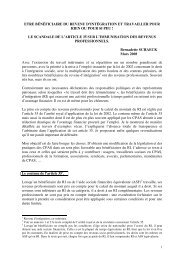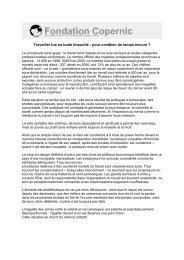Awra Amba RJ 300612 EN - Contacter un comité local d'Attac
Awra Amba RJ 300612 EN - Contacter un comité local d'Attac
Awra Amba RJ 300612 EN - Contacter un comité local d'Attac
You also want an ePaper? Increase the reach of your titles
YUMPU automatically turns print PDFs into web optimized ePapers that Google loves.
<strong>Awra</strong> <strong>Amba</strong>, a current experiment of utopian socialism<br />
According to the 1994 Education and training policy of Ethiopia, first cycle is a primary education<br />
that comprises grades 1 through 4 and gives basic education.<br />
Picture 16: The <strong>Awra</strong> <strong>Amba</strong> public school in April 2010.<br />
There were in level 1 to 8 in April 2008 613 students aged 7-16 (from the age of 5 or 6 according to<br />
Yi07/4 – Question 36 in Annex), including 164 from <strong>Awra</strong> <strong>Amba</strong>. They have one hour of<br />
preparation and four teaching hours a day from Monday to Friday, from 7am to noon or from 12.30<br />
to 17.45. In March 2012, these same levels 1 to 8 are attended by 764 students, whereas levels 9 and<br />
10 are attended among others by 13 children from <strong>Awra</strong> <strong>Amba</strong> (Crespo, 2012). The <strong>Awra</strong> <strong>Amba</strong><br />
school has been growing rapidly in the number of students enrolled (by 25 % in two years), which<br />
would be due to its higher level than its neighbours according to comm<strong>un</strong>ity members (Crespo,<br />
2012).<br />
In the first cycle, each class has a single teacher, whereas in the higher levels, a teacher teaches<br />
several classes, probably per subject (Yi07/74). Curricula are produced by the Amhara region<br />
(Yi07/84). According to our survey on site in 2010, teachers earn on average 973 birrs a month, i.e.<br />
54 Euros, with a pension of 50 % at age 60 approximately. Pay goes from 35 Euros a month for a<br />
teacher with one year of training after level 10, to 71 Euros for those who completed the first four<br />
years of <strong>un</strong>iversity. Most of the teachers came from Amhara region and some from Harar region,<br />
about a thousand kilometres away.<br />
The students from <strong>Awra</strong> <strong>Amba</strong> are admitted in grade one at the age of six or seven, after having<br />
attended the village kindergarten, whereas students from neighbouring villages can attend school for<br />
the first time at the age of 14, even later (Yi07/73-74). The school gives an entrance exam to the new<br />
students, and they can enter directly grade two to five according to their level: because they have<br />
attended either the church school, or the <strong>Awra</strong> <strong>Amba</strong> kindergarten, or an alternative three-year<br />
education programme (Yi07/89-90). Moving from one cycle to another is not made at a fixed age,<br />
but according to the level (Crespo, 2012). Yirga (2007, 89-90) thinks the <strong>Awra</strong> <strong>Amba</strong> children have<br />
the privilege compared to children from neighbouring comm<strong>un</strong>ities of being able to skip the first<br />
grades without having really attended school: it is in our opinion more the result of the progressive<br />
behaviour of the <strong>Awra</strong> <strong>Amba</strong> comm<strong>un</strong>ity facing children and education, rather than an <strong>un</strong>due<br />
privilege.<br />
The <strong>Awra</strong> <strong>Amba</strong> children are more hard-working than others: the attendance rate is 100 % for the<br />
comm<strong>un</strong>ity children, but only 90 % for the other students according to the head master, Mohamed<br />
Alemie, 29 (Jo10b/7). Before going to school, they gather in the village centre <strong>un</strong>der the authority of<br />
a member of the education committee (Yi07/80): see Picture 17. They are the first to arrive –<br />
grouped – at school, and the last to leave – in line, 10-15 minute after others. These grouped journeys<br />
– the smaller in front – is the expression of their solidarity: "if we do not help each other, we are not<br />
different from animals". But at the same time, it forbids chance enco<strong>un</strong>ters with yo<strong>un</strong>g neighbours<br />
and therefore to interact with them (Yi07/81-82).<br />
66 / 85

















